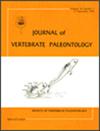格里里无齿龙的新标本与重新描述(莫恩科皮组:三叠纪中期)及三棱龙科的时空起源
IF 1.9
4区 地球科学
Q2 PALEONTOLOGY
引用次数: 1
摘要
本文章由计算机程序翻译,如有差异,请以英文原文为准。
New specimen and redescription of Anisodontosaurus greeri (Moenkopi Formation: Middle Triassic) and the spatiotemporal origins of Trilophosauridae
ABSTRACT Anisodontosaurus greeri is an enigmatic small-bodied tetrapod with a heterodont dentition from the Holbrook Member of the Moenkopi Formation (Middle Triassic) of Arizona (U.S.A.). The evolutionary relationships of this taxon have long been debated and remain uncertain. Using micro-computed tomography (µCT) scans we redescribe the holotype of Anisodontosaurus greeri (UCMP 37804), as well as an additional specimen (MNA.V.1478) that had been informally referred to this taxon. Our new data reveal hidden details of the dentition (i.e., ankylothecodonty and absence of replacement teeth) that, in combination with the tricuspid and mediolaterally expanded crowns, support a referral of both specimens to the archosauromorph clade Trilophosauridae. The referral of MNA.V.1478 to Anisodontosaurus greeri is supported by the unique anatomy of the highly differentiated dentition (i.e., ‘figure of 8’-shaped premolariforms in occlusal views; mesiodistally short tooth row; presence of a distal ‘molariform’ crown). Comparison of Anisodontosaurus greeri with other trilophosaurids highlights marked similarities with Variodens inopinatus from the Upper Triassic deposits of the U.K. Our cladistic analyses confirm these observations, and recover, for the first time, two distinct lineages within Trilophosauridae: one geologically long-lived and comprising Anisodontosaurus and Variodens; and one comprising Tricuspisaurus, Trilophosaurus spp., and Spinosuchus. These results imply that: (i) Anisodontosaurus is one of the oldest known trilophosaurids worldwide and the oldest in North America; (ii) trilophosaurids achieved a broad distribution at low latitudes within western Pangea by the Middle Triassic; (iii) small body sizes were more common than previously thought among trilophosaurids.
求助全文
通过发布文献求助,成功后即可免费获取论文全文。
去求助
来源期刊
CiteScore
2.90
自引率
7.10%
发文量
58
审稿时长
4-8 weeks
期刊介绍:
The Journal of Vertebrate Paleontology publishes original contributions on all aspects of vertebrate paleobiology, including vertebrate origins, evolution, functional morphology, taxonomy, biostratigraphy, phylogenetics, paleoecology, paleobiogeography, and paleoanthropology. JVP publishes high quality peer-reviewed original articles, occasional reviews, and interdisciplinary papers. It is international in scope, and emphasizes both specimen- and field-based based research and the use of high-quality illustrations. Priority is given to articles dealing with topics of broad interest to the entire vertebrate paleontology community and to high-impact specialist studies. Articles dealing with narrower topics, including notes on taxonomic name changes (unless these deal with errors published in JVP), preliminary site reports, and documentation of new specimens of well-known taxa, are afforded lower priority.

 求助内容:
求助内容: 应助结果提醒方式:
应助结果提醒方式:


